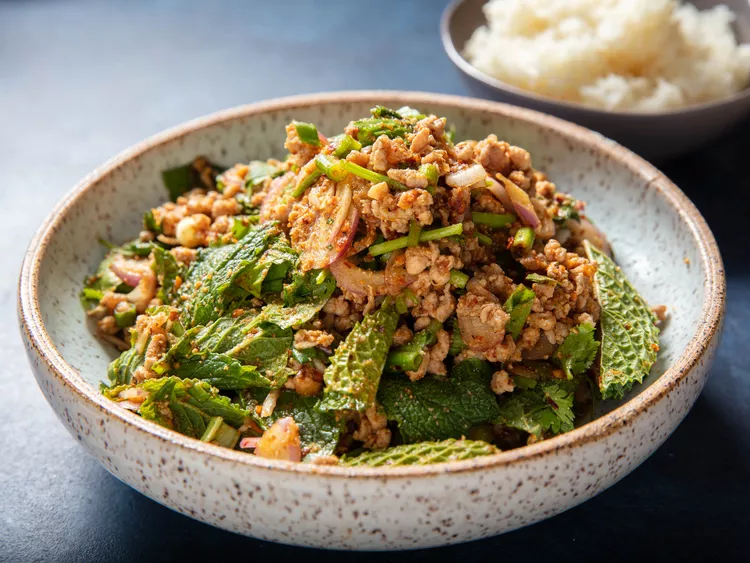Thai Isan-Style Minced Pork Salad

https://www.seriouseats.com/laab-moo-isan-isan-style-minced-pork-salad-5205873
INGREDIENTS
- 8 ounces (225g) ground pork, preferably coarsely ground pork shoulder (see note)
- 2 tablespoons plus 1 teaspoon (35ml) fish sauce, plus extra as needed
- 2 tablespoons plus 1 teaspoon (35ml) fresh lime juice from 1 lime, plus extra as needed
- 1 teaspoon (5g) sugar (optional, see note)
- 1 ½ teaspoons to 1 tablespoon (7 to 15g) coarsely ground dried Thai chiles, divided
- 1 medium shallot (50g), thinly sliced
- 5 sprigs (10g) fresh culantro leaves and tender stems, cut into 1-inch pieces (see note)
- 6 sprigs (10g) fresh cilantro leaves and tender stems, cut into 1-inch pieces
- 2 scallions (20g), sliced into 1/8-inch-thick rounds
- 2 tablespoons (30g) Thai Toasted-Rice Powder
- ½ cup (10g) fresh mint leaves
- Cooked Thai Sticky Rice for serving
DIRECTIONS
-
In a 3-quart saucier, bring 2 tablespoons (30ml) water to a boil over high heat. Add pork and cook, stirring vigorously with a large spoon to break up any large clumps, until meat turns gray and is cooked through, about 2 minutes. Remove from heat, and allow pork to cool for 30 seconds.
-
Add fish sauce, lime juice, sugar (if using), and 1 ½ teaspoons (7g) ground chile. Stir to combine and then allow to cool for 5 minutes.
-
Add shallot, culantro (if using), cilantro, and scallions, and stir to combine. At this point, make sure you have everything ready to go that you plan to serve with the laab, such as sticky rice. Once you are ready to serve, add khao khua and stir until thoroughly combined and most of the liquid in the saucepan has been absorbed, 10 to 15 seconds. Add mint and stir gently until just combined. Taste and adjust seasoning with more fish sauce, ground chiles, and/or lime juice as needed. The salad should be assertive—acidic, salty, and spicy—but balanced. Serve immediately with cooked sticky rice.
TIPS
- Culantro, also known as sawtooth coriander, is a common addition to laab moo Isan. It adds a peppery and slightly bitter herbal note to the dish. Culantro can be found in Southeast Asian, Central American, and Caribbean markets. If you cannot find culantro, double the amount of cilantro in the recipe.